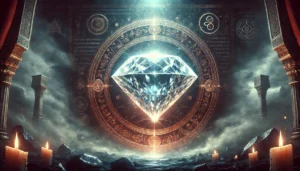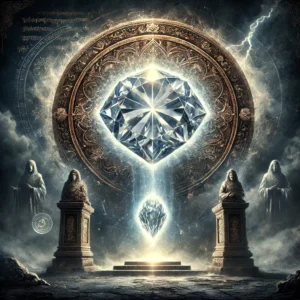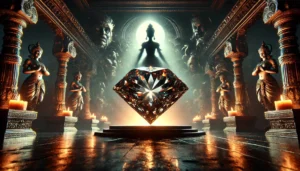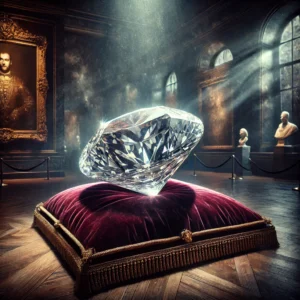
Is the Kohinoor Diamond cursed?
The Curse of the Kohinoor Diamond: Truth or Superstition?
The Kohinoor diamond, one of the most famous and controversial gems in the world, has a rich and complex history. It is renowned not just for its brilliance and size but also for the tales of misfortune that seem to follow its possessors. Often referred to as the “Mountain of Light,” the Kohinoor has been the centerpiece of legend, power struggles, and a supposed curse that continues to fascinate and mystify. This article delves deeper into the intricate tapestry of the Kohinoor’s history, the origins of its supposed curse, and the ongoing debate about whether this curse is a genuine phenomenon or merely a product of superstition.
The History of the Kohinoor
Early Beginnings
The Kohinoor’s early history is veiled in legend, with its first confirmed appearance in historical records occurring in the 13th century. It was mined from the Kollur Mine in the Golconda region, which was renowned for producing some of the world’s finest diamonds. The diamond’s name, “Kohinoor,” which means “Mountain of Light” in Persian, reflects the awe it inspired from the very beginning.
A Jewel of Empires
Throughout its early history, the Kohinoor was a coveted treasure for rulers in India. It passed through the hands of several prominent dynasties, including the Kakatiyas, Khiljis, Tughlaqs, and ultimately the Mughals. The Mughal emperor Babur mentioned the diamond in his memoirs, referring to it as a precious gem taken from the treasury of the Sultan of Delhi.
The diamond’s journey continued through the courts of the Persians and the Afghans. Each transfer of ownership often came as a result of bloody battles, conquests, and betrayals, cementing its reputation as an object of both immense value and ominous power.
Arrival in the British Crown
The Kohinoor’s most significant and controversial transfer occurred in 1849, following the British annexation of Punjab. The young Maharaja Duleep Singh, under duress, signed away his kingdom and the gem to the British East India Company. The diamond was subsequently presented to Queen Victoria and became a part of the British Crown Jewels, where it remains today.
Table of Contents

Is the Kohinoor Diamond cursed?
The Curse Legend
Origins of the Curse
The legend of the Kohinoor’s curse likely stems from its tumultuous history and the violent means by which it changed hands. The belief that the diamond brings bad luck and misfortune to its male possessors, while sparing female owners, is deeply rooted in Indian folklore.
Spread of the Curse Myth
When the Kohinoor reached British shores, stories of its curse were already well-known. The British Royal Family, perhaps influenced by these tales, decided that the diamond would only be worn by female members of the family. Queen Victoria herself was said to have been wary of the diamond’s reputed curse.
The narrative of the curse was further popularized by newspapers and authors, who embellished the gem’s history with tales of woe and doom. These stories served to enhance the mystique of the diamond, adding an exotic allure that captivated the public imagination.
Truth or Superstition?
Historical Evidence
Analyzing the historical record, it is clear that the Kohinoor has been involved in numerous unfortunate events. However, these events can largely be attributed to the turbulent political and social circumstances of the times. The diamond was often a prize of war, and its ownership was contested by some of the most powerful and ambitious rulers of the era.
Psychological and Sociological Factors
The belief in the curse can also be understood through psychological and sociological lenses. The idea of cursed objects is a common theme across many cultures, serving as cautionary tales about greed, power, and the consequences of human folly. The Kohinoor’s legend fits neatly into this archetype, reinforcing the belief in supernatural retribution.
Colonial Influence and Myth-Making
The British colonial narrative played a significant role in shaping the legend of the Kohinoor. By framing the diamond as a cursed but prized possession, the British added an element of drama and mystery that bolstered their claim to the gem. The curse myth also served to exoticize and mystify the cultural heritage of India, feeding into colonial narratives of dominance and control.

Is the Kohinoor Diamond cursed?
The Modern Debate
Calls for Repatriation
In recent years, the Kohinoor has become a focal point for discussions about colonialism and cultural heritage. Several countries, including India, Pakistan, and Afghanistan, have laid claim to the diamond, arguing that it was taken under duress and should be returned to its place of origin.
The Curse in Popular Culture
The Kohinoor’s legend continues to be a source of fascination in popular culture. It has been featured in books, films, and television shows, often depicted as a cursed object with a dark and mysterious past. This portrayal keeps the myth of the curse alive, even in the modern era.
Conclusion
The Kohinoor diamond is a symbol of both magnificence and misfortune, its story intertwined with the histories of empires and nations. While the legend of its curse may be more fiction than fact, it remains a powerful narrative that captures the imagination.
Whether one believes in the curse or sees it as a mere superstition, the Kohinoor’s legacy is undeniable. It stands as a testament to the complexities of history, the allure of precious objects, and the enduring power of myth and legend. As debates about its rightful ownership and the veracity of its curse continue, the Kohinoor will undoubtedly remain one of the most enigmatic and captivating jewels in the world.

Is the Kohinoor Diamond cursed?
FAQs on “Kohinoor Diamond: Curse or Myth?”
- What is the Kohinoor Diamond?
The Kohinoor Diamond is one of the most famous and valuable diamonds in the world, weighing around 105.6 carats. Its name means “Mountain of Light” in Persian, and it has a long history of being part of various royal treasuries across the Indian subcontinent.
- Why is the Kohinoor Diamond considered cursed?
The diamond is believed to bring bad luck, misfortune, and even death to any male who possesses it. Legends suggest that it has brought down empires and led to the downfall of rulers throughout its history.
- What is the origin of the Kohinoor Diamond?
The diamond is believed to have been mined from the Kollur Mine in India during the 13th century. Its exact early history is unclear, but it has been mentioned in various historical texts as a prized and coveted gem.
- Is there any historical evidence supporting the curse?
Although numerous rulers who owned the diamond experienced significant misfortunes, these events are not definitively linked to the diamond itself. The stories of the curse are more likely rooted in legend and coincidence rather than factual evidence.
- Who were some of the notable owners of the Kohinoor Diamond?
The Kohinoor has been owned by various prominent figures, including the Kakatiya dynasty of India, the Delhi Sultanate, the Mughal Emperors, Nader Shah of Persia, Ahmad Shah Durrani of Afghanistan, Maharaja Ranjit Singh of Punjab, and finally the British monarchy.
- How did the Kohinoor Diamond end up in the British Crown Jewels?
After the British annexed the Punjab region in 1849, the diamond was ceded to the British East India Company. It was then presented to Queen Victoria and became part of the British Crown Jewels, symbolizing British imperial power.
- Is the curse of the Kohinoor Diamond still believed today?
The curse is largely considered a superstition in modern times. While some people still believe in its ominous powers, many view the stories as part of the diamond’s colorful history rather than factual accounts.
- Can the curse affect women who wear the Kohinoor Diamond?
According to legend, the curse specifically targets men, sparing women from its alleged effects. This belief is likely rooted in the historical context where women, particularly queens, often wore the diamond without misfortune.
- Has the Kohinoor Diamond been involved in any recent controversies?
Yes, the diamond has been the subject of multiple claims and demands for its return by countries like India, Pakistan, Afghanistan, and Iran. Each country cites historical ties and ownership claims, making the Kohinoor a symbol of colonial legacy and cultural heritage disputes.
- What is the current status of the Kohinoor Diamond?
The Kohinoor Diamond is currently set in the front of the Queen Mother’s Crown and is displayed in the Tower of London as part of the British Crown Jewels collection. It remains a popular attraction for visitors.
- Is there any scientific explanation for the belief in the curse?
The belief in the curse may be attributed to psychological phenomena such as confirmation bias, where people tend to focus on events that support the idea of the curse while ignoring those that don’t. Additionally, the human tendency to find meaning in randomness and the dramatic history of the diamond contribute to the perpetuation of the myth.
- What are some famous legends associated with the Kohinoor Diamond?
One famous legend states that the diamond was originally part of a larger stone that formed the eye of a Hindu deity’s statue. Another story suggests that whoever possesses the diamond will rule the world but suffer great personal loss. These legends have fueled the mystery and allure surrounding the Kohinoor.
- How has the Kohinoor Diamond influenced popular culture?
The Kohinoor has been referenced in various books, films, and TV shows as a symbol of immense wealth and power. Its enigmatic history and alleged curse have made it a compelling subject for storytellers and historians alike.
- Are there any other diamonds with similar legendary curses?
Yes, other famous diamonds like the Hope Diamond and the Black Orlov Diamond also have legends of curses associated with them. These stories often involve misfortunes befalling their owners, adding to the mystique and allure of these precious gems.
- What does the Kohinoor Diamond symbolize today?
Today, the Kohinoor Diamond symbolizes not only beauty and wealth but also the complex history of colonialism and cultural heritage. It remains a point of contention in discussions about rightful ownership and historical restitution.
Summary
Kohinoor Diamond: Curse or Myth?
The Kohinoor diamond, one of the most famous and historically significant gemstones in the world, has long been shrouded in mystery and legend. Known for its exceptional size and brilliance, the diamond has a rich and tumultuous history, spanning several centuries and numerous rulers across Asia and Europe. Alongside its dazzling allure, the Kohinoor carries the weight of a notorious curse—said to bring misfortune and tragedy to any man who wears it.
The diamond’s origins can be traced back to ancient India, where it was mined in the Golconda region. Over the centuries, it passed through the hands of various Indian dynasties, including the Mughals, before being seized by Persian, Afghan, and Sikh rulers. Each transfer of ownership was often marked by bloodshed and betrayal, reinforcing the belief in the diamond’s malevolent power.
The legend of the curse gained prominence after the British took possession of the Kohinoor during the colonial era. Following the defeat of the Sikh Empire in 1849, the diamond was formally presented to Queen Victoria and became part of the British Crown Jewels. Since then, the Kohinoor has been associated with a string of unfortunate events in the British royal family, further fueling the narrative of its ominous influence.
Critics, however, argue that the so-called curse is a product of superstition and historical coincidence. They contend that the tumultuous history of the Kohinoor reflects the turbulent times in which it existed, rather than any supernatural force. The diamond’s journey through various empires and rulers was shaped by political ambition, greed, and the quest for power, common themes in the annals of history.
Despite the debate, the allure of the Kohinoor’s legend persists. Its storied past, combined with its unparalleled beauty, continues to captivate the imagination of people around the world. Whether viewed as a cursed gem or a symbol of imperial conquest, the Kohinoor diamond remains an enduring enigma—a testament to the enduring fascination with the interplay between myth and history.
Related Articles
- Restful Nights: Ayurvedic Remedies and Traditional Indian Practices to Overcome Insomnia and Late-Night Habits
- The Tridevi: Lakshmi, Saraswati, and Parvati – Their Roles and Powers
- “Divine Creatures of Ancient Indian Scriptures: Exploring the Role of Animals in the Vedas, Puranas, and Mahabharata”
- Nature and Spirituality: Exploring the Sacred Essence of the Himalayas, Ganga, and Other Natural Wonders”
- “Reviving the Gurukul System: Relevance and Lessons for Modern Education”
- “Exploring Greek and Indian Mythology: Similarities Between Greek and Indian Mythology “
- “Embracing Sattvic Living: Harmonizing Mind, Body, and Soul Through Food and Lifestyle”
- “Charity and Prosperity: Exploring the Concept of Daan and Its Financial Relevance in Modern Life”
- How to Build an Eco-Friendly Home Inspired by Vastu Shastra
- Comparison of Ancient and Modern Sports: How Traditional Sports Have Influenced Contemporary Games
- “Timeless Lessons from Ancient Tales: Linking Samudra Manthan and Ganga’s Descent to Modern Ecological Challenges”
- “Reviving Sanskrit: How AI is Preserving Ancient Languages for the Future”
- “Mathura: The Sacred Land of Lord Krishna’s Divine Leelas”
- Investing for Future Generations: Lessons from Indian Traditions on Legacy Building and Wealth Preservation
- “Ancient Indian Wisdom: Timeless Lessons for Tackling Today’s Climate Crisis”
- “Artificial Intelligence and Spirituality: Transforming Ancient Practices for the Modern World”
- “Gold and Real Estate in India: Timeless Assets Shaping Financial Strategies”
- Tradition Meets Innovation: The Evolution of Technology in Hindu Rituals
- End-of-World Myths: Exploring Kali Yuga in Hinduism and Ragnarök in Norse Mythology
- Garuda, Pegasus, and Dragons: The Universal Ties of Mythical Beasts Across Cultures
- “Ancient Vimanas: Mythical Flying Machines or Evidence of Advanced Technology?”
- Time Travel in Hindu Mythology: The Fascinating Tales of Kakudmi and King Raivata
- “Divine Feminine Power in Hindu Mythology: The Legends of Durga, Saraswati, and Lakshmi”
- “Divine Beings of Sanatan Dharma: The Spiritual Significance of Sacred Animals in Hinduism”
- “Symbolism in Mythological Art: Unlocking Hidden Meanings in Ancient Temple Carvings”
- “Exploring Technological Advancements in Ancient India and Civilizations: Vimana, Metallurgy, & Water Management systems”
- Unveiling the Mysteries: Ancient Temples of Sanatan Dharma , Mysterious Temples of India
- “The Scientific Knowledge of Sanatan Dharma: Ancient Wisdom Meets Modern Science”
- Ancient Indian Sports and Games: Celebrating a Legacy of Skill, Strength & Strategy”
- “Exploring the Cosmic Link: The Connection Between Astronomy and Vedic Astrology”
- The Power of Sanskrit: Unlocking the Divine Language of the Gods
- “The End of Kaliyuga: A Sanatan Insight into the World’s Final Chapter”
- Explore more articles on Prachin Sanatan Yuga.
Is the Kohinoor Diamond cursed? Is the Kohinoor Diamond cursed? Is the Kohinoor Diamond cursed? Is the Kohinoor Diamond cursed? Is the Kohinoor Diamond cursed? Is the Kohinoor Diamond cursed? Is the Kohinoor Diamond cursed? Is the Kohinoor Diamond cursed? Is the Kohinoor Diamond cursed? Is the Kohinoor Diamond cursed? Is the Kohinoor Diamond cursed?
Is the Kohinoor Diamond cursed? Is the Kohinoor Diamond cursed? Is the Kohinoor Diamond cursed? Is the Kohinoor Diamond cursed? Is the Kohinoor Diamond cursed? Is the Kohinoor Diamond cursed? Is the Kohinoor Diamond cursed? Is the Kohinoor Diamond cursed? Is the Kohinoor Diamond cursed? Is the Kohinoor Diamond cursed? Is the Kohinoor Diamond cursed?
